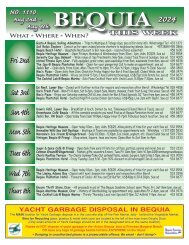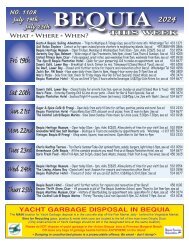Caribbean Compass Yachting Magazine - May/June 2022
Welcome to Caribbean Compass, the most widely-read boating publication in the Caribbean! THE MOST NEWS YOU CAN USE - feature articles on cruising destinations, regattas, environment, events...
Welcome to Caribbean Compass, the most widely-read boating publication in the Caribbean! THE MOST NEWS YOU CAN USE - feature articles on cruising destinations, regattas, environment, events...
You also want an ePaper? Increase the reach of your titles
YUMPU automatically turns print PDFs into web optimized ePapers that Google loves.
MAY/JUNE <strong>2022</strong> CARIBBEAN COMPASS PAGE 22<br />
A New Look at Hurricanes and the<br />
Eastern <strong>Caribbean</strong> Sailing Season<br />
by Don Street<br />
<strong>June</strong>, too soon<br />
I recently made a discovery that could revolutionize the<br />
<strong>Caribbean</strong> charter yacht business. It offers an opportunity<br />
to extend the charter season an extra six weeks, while<br />
enjoying the best sailing weather of the year.<br />
Checking NOAA’s records on hurricane activity in<br />
the North Atlantic, I saw that from 1851 to 2020 only<br />
two hurricanes had ever hit the islands of the Eastern<br />
<strong>Caribbean</strong> during the month of <strong>June</strong> and the first two<br />
weeks of July.<br />
During this period the wind blows 10 to 12 knots<br />
— seldom less and never more, except in brief squalls.<br />
But bareboat charter companies often have their fleets<br />
already secured for hurricane season.<br />
The low risk of hurricanes before mid-July is of<br />
particular interest to the charter boats and<br />
organizations operating in the Virgin Islands. The west<br />
coast of Virgin Gorda, north coast of Tortola, northwest<br />
of coast of St. Thomas, and north coasts of Culebra<br />
and Culebrita all have magnificent white sand beaches<br />
where boats do not anchor in the winter because of the<br />
groundswell. However, groundswell season ends<br />
approximately mid-April. This gives a full ten weeks of<br />
wonderful cruising after the groundswells end and the<br />
risk of hurricanes increases. If charter brokers and<br />
charter companies advertise this “shoulder” period, I<br />
feel in the next few years it will revolutionize the<br />
charter season.<br />
<strong>June</strong> and early July are great for cruising sailors,<br />
too. The weather is lovely and the anchorages will be<br />
less crowded — at least until the charter companies<br />
catch on!<br />
Minimizing hurricane risk on the hard<br />
<strong>May</strong> and <strong>June</strong>, while you’re enjoying the great<br />
sailing, is also the time for boat owners to organize<br />
what you’re going to do with your boat for hurricane<br />
season. If you are going to lay up ashore, contact the<br />
yards you’re interested in, ask how many boats they<br />
can haul and how many (if any) blew out of their<br />
cradles or jack stands the last time the yard was hit by<br />
hurricane. Ask what, if any, changes have been made<br />
to minimize the chance of that happening again.<br />
Make your decision on what yard to choose after you<br />
have verified with your insurance company or<br />
underwriter that you will be covered for hurricane<br />
damage there. It is also important to obtain from the<br />
yard manager a signed agreement that the boats on<br />
either side of yours will also be properly laid up to<br />
withstand a hurricane. Book early, since the popular<br />
boatyards will fill up fast.<br />
Properly stored boats can survive a direct hit from a<br />
hurricane, and strapping boats down to “dead men,”<br />
or ground anchors, seems to be key. For example, in<br />
2017 as a hurricane approached Marina del Rey in<br />
Puerto Rico, a 38-foot boat with a fin keel was hauled<br />
at the last minute. After the hurricane passed the boat<br />
was still standing upright, although the jack stands<br />
had blown away. It was held upright by heavy straps<br />
secured to dead men.<br />
Also be aware of the amount of pressure per square<br />
foot generated by high winds. The pressure per square<br />
foot goes up with the square of the wind velocity. At 60<br />
mph the pressure is nine pounds per square foot; at<br />
120 mph it is 37 pounds per square foot; at 180 mph<br />
it is 83 pounds per square foot!<br />
So, should the mast be unstepped for hurricane<br />
storage? The load in pounds on a 60-foot mast is<br />
exerted about 30 feet above the deck. At 100 mph, the<br />
load is 1,700 pounds; at 120 mph, 2,245 pounds; at<br />
140 mph, 3,350 pounds; at 160 mph, 2,425 pounds;<br />
and at 180 mph, 5,450 pounds. These loads might be<br />
bearable when the wind is in line with the axis of the<br />
boat. But with the wind on the beam, with these loads<br />
centered at 30 feet above the deck, will a boat on the<br />
hard stay upright?<br />
Even if you decide to leave the mast standing,<br />
dodgers, biminis, spray curtains, and all sails should<br />
Above: <strong>June</strong> and July are idyllic times to cruise.<br />
Below: One of only two November hurricanes since<br />
1851 to strike the Eastern <strong>Caribbean</strong>, 1999’s Lenny<br />
put this freighter ashore in St. Maarten.<br />
come off. Wrapping a roller-furling jib in its sheets<br />
might keep it from unfurling, but this gift-wrapped<br />
bundle presents a lot of windage aloft. All halyards<br />
except the main halyard should be run up to the top<br />
of the mast. The boom can be detached and lashed<br />
down along the toerail.<br />
If you cannot lay up your boat yourself and must rely<br />
on the yard to do the job, give the yard detailed written<br />
instructions on what should be done. I highly<br />
recommended that you hire a surveyor, and give him<br />
or her a copy of those instructions and a letter of<br />
authority, so that he or she can make sure the yard<br />
lays up your boat properly. This will be money very<br />
well spent.<br />
STEVE JOST<br />
See more many more tips on minimizing hurricane<br />
season risk for boats stored<br />
in the <strong>Caribbean</strong> at www.street-ilolaire.com<br />
and on page page 24 at<br />
www.caribbeancompass.com/online/<br />
march18compass_online.pdf.<br />
If not hauled out<br />
Don’t leave a boat for the summer on a hurricane<br />
mooring unless the location is completely remote from<br />
all other boats. Even if your boat is on a good mooring,<br />
the chances of it being hit by another boat dragging or<br />
adrift in a storm might be high. That is how I lost Li’l<br />
Iolaire — a 28-foot yawl could not survive being<br />
attacked by 55-foot catamaran!<br />
If you are going to stay on the boat and keep it in<br />
commission in hurricane season, what to do if a<br />
hurricane is aimed at your anchorage? Forget about<br />
riding out a hurricane on anchors or a hurricane<br />
mooring. Be ready to take evasive action.<br />
As soon as depressions off the coast of Africa below<br />
the Cape Verdes or sometimes farther west pick up a<br />
circular motion, they are named and tracked by<br />
NOAA. Once the wind is over 42 knots they are<br />
labeled tropical storms. At 62 knots they become<br />
hurricanes, which can blow anywhere from 62 to 180<br />
knots or more.<br />
The alert sailor should be tracking these systems<br />
daily (or even more frequently) via the US National<br />
Hurricane Center at www.nhc.noaa.gov.<br />
If properly anchored with appropriate gear, you<br />
should be able to weather a tropical storm (winds up<br />
to 62 knots). But remember that the load on your gear<br />
goes up with the square of the wind speed. Thus, in 40<br />
knots of wind the load on the anchor line will be four<br />
times the load at 20 knots. At 60 knots of wind the<br />
load will be six times the load at 20 knots.<br />
Then consider the loads in hurricane-force winds. If<br />
the load on your anchor line is 500 pounds at 20 knots<br />
it will be 8,000 pounds at 120 knots. Anchors drag,<br />
rodes break, windlasses tear out of the decks.<br />
If a potential hurricane is approaching the Eastern<br />
<strong>Caribbean</strong> across the Atlantic, as long as it stays<br />
below 19°N its track can be predicted with a very high<br />
degree of reliability. The tracks almost never curve<br />
south of west; they almost always curve north of west.<br />
Hurricanes tracking west, down in the very low<br />
latitudes, 11° or 12°N, like Ivan, occasionally do turn<br />
slightly south, but seldom more than five degrees in<br />
24 hours. A few zigs to the south have lasted 48 hours,<br />
and one 72 hours, before turning west.<br />
If a hurricane looks like it is heading for you, 48<br />
hours before it is predicted to hit, head south or<br />
southwest, sailing or motor sailing. If your boat is<br />
making six knots, in 24 hours you will be 150 miles<br />
south of the hurricane, and in 36 hours, 225 miles —<br />
well clear of any strong winds.<br />
But if a hurricane is predicted to hit the island<br />
immediately to the south of you, that’s a problem. Do<br />
you sit tight and figure that the center of the hurricane<br />
is far enough south that the wind north of the center<br />
will be at a velocity that you can handle at your<br />
anchorage or in your marina, or do you head farther<br />
south? Now is the time to contact a professional<br />
weather router and pay his or her fee!<br />
When hurricanes hit the islands of the Eastern<br />
<strong>Caribbean</strong> they are often small in diameter but frequently<br />
very intense, as seen when Hurricane Maria devastated<br />
Dominica but did no significant damage to the southern<br />
end of Guadeloupe or the northern end of Martinique.<br />
Once hurricanes go above 19° and get into the warm<br />
waters of the Bahamas, or pass through the islands of<br />
the Eastern <strong>Caribbean</strong> and get into the warm water of<br />
the <strong>Caribbean</strong> Sea, they frequently increase in size<br />
and ferocity.<br />
—Continued on next page

















